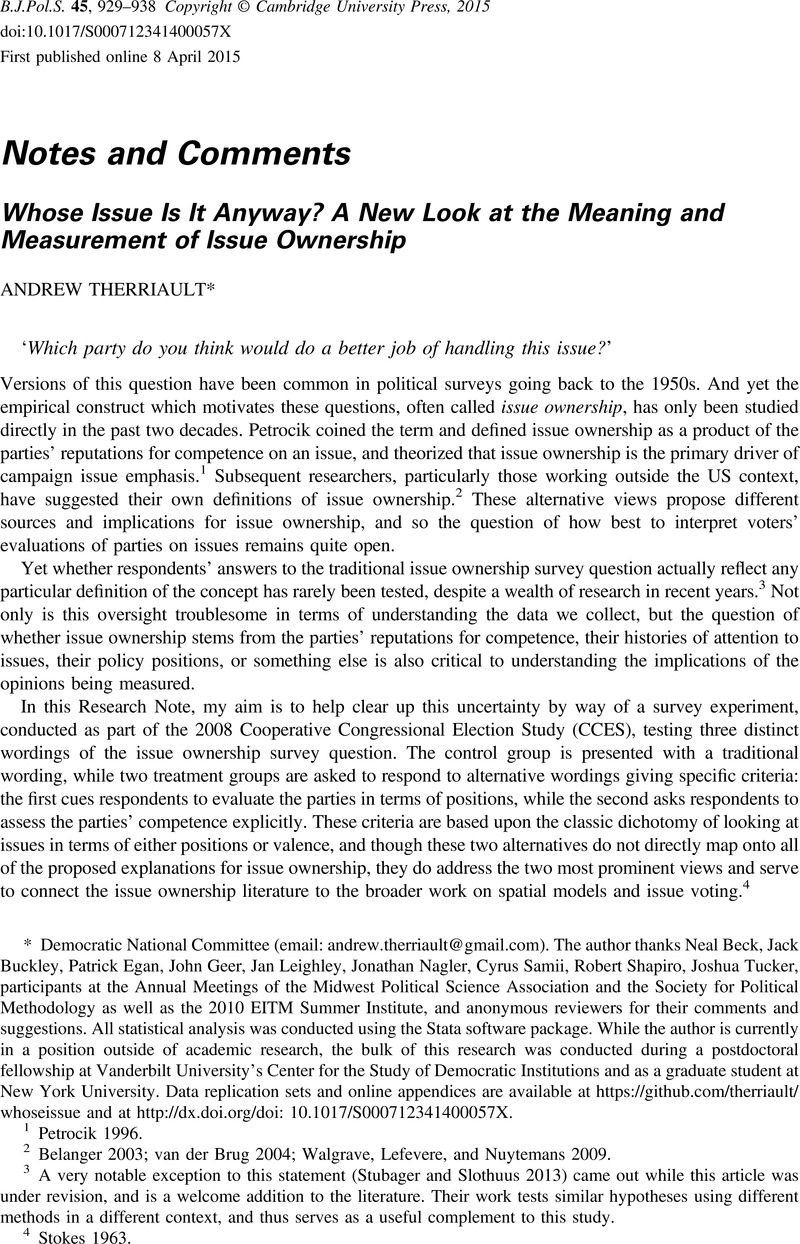Crossref Citations
This article has been cited by the following publications. This list is generated based on data provided by
Crossref.
Walgrave, Stefaan
Van Camp, Kirsten
Lefevere, Jonas
and
Tresch, Anke
2016.
Measuring issue ownership with survey questions. A question wording experiment.
Electoral Studies,
Vol. 42,
Issue. ,
p.
290.
Lefevere, Jonas
Walgrave, Stefaan
Stubager, Rune
and
Tresch, Anke
2017.
Measuring Issue Ownership: A Comparative Question Wording Experiment.
Scandinavian Political Studies,
Vol. 40,
Issue. 1,
p.
120.
Goggin, Stephen N.
and
Theodoridis, Alexander G.
2017.
Disputed Ownership: Parties, Issues, and Traits in the Minds of Voters.
Political Behavior,
Vol. 39,
Issue. 3,
p.
675.
Craig, Stephen C.
and
Cossette, Paulina S.
2017.
WHOSE ISSUE IS IT ANYWAY… AND DOES IT REALLY MATTER? Issue Ownership and Negative Campaigning.
World Affairs,
Vol. 180,
Issue. 3,
p.
72.
Seeberg, Henrik Bech
2017.
How Stable Is Political Parties’ Issue Ownership? A Cross-Time, Cross-National Analysis.
Political Studies,
Vol. 65,
Issue. 2,
p.
475.
Stubager, Rune
2018.
What is Issue Ownership and How Should We Measure It?.
Political Behavior,
Vol. 40,
Issue. 2,
p.
345.
Tresch, Anke
and
Feddersen, Alexandra
2019.
The (In)stability of Voters’ Perceptions of Competence and Associative Issue Ownership: The Role of Media Campaign Coverage.
Political Communication,
Vol. 36,
Issue. 3,
p.
394.
Seeberg, Henrik Bech
2020.
How political parties’ issue ownerships reduce to spatial proximity.
West European Politics,
Vol. 43,
Issue. 6,
p.
1238.
Craig, Stephen C.
and
Cossette, Paulina S.
2020.
Who Owns What, and Why? The Origins of Issue Ownership Beliefs.
Politics & Policy,
Vol. 48,
Issue. 1,
p.
107.
Downes, James Floyd
Loveless, Matthew
and
Lam, Andrew
2021.
The Looming Refugee Crisis in the EU: Right‐Wing Party Competition and Strategic Positioning.
JCMS: Journal of Common Market Studies,
Vol. 59,
Issue. 5,
p.
1103.
Clifford, Scott
2022.
How Moral Motives Link Party Stereotypes.
Political Behavior,
Vol. 44,
Issue. 2,
p.
705.
Enders, Adam M.
Gainous, Jason
and
Wagner, Kevin M.
2022.
Say it again with feeling: Issue ownership and candidate communication using Twitter.
Social Science Quarterly,
Vol. 103,
Issue. 4,
p.
959.
McLaughlin, Peter T.
Geras, Matthew J.
and
Rhinehart, Sarina
2024.
Supporting Veterans: Source Cues, Issue Ownership,and the Electoral Benefits of Military Service.
Political Behavior,
Vol. 46,
Issue. 1,
p.
307.



